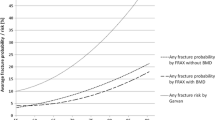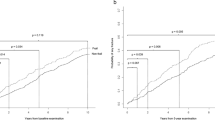Abstract
Introduction
When subjects are selected on the basis of fall risk alone, therapies for osteoporosis have not been effective. In a prospective study of elderly subjects at high risk of falls, we investigated the influence of bone strength and fall risk on fracture.
Methods
At baseline we assessed calcaneal bone ultrasound attenuation (BUA) as well as quantitative measures of fall risk in 2005 subjects in residential care. Incident falls and fractures were recorded (median follow-up 705 days).
Results
A total of 6646 fall events and 375 low trauma fracture events occurred. The fall rate was 214 per 100 person years and the fracture rate 12.1 per 100 person years. 82% of the fractures could be attributed to falls. Although fracture rates increased with decreasing BUA (incidence rate ratio 1.94 for lowest vs. highest BUA tertile, p<0.002), incident falls also affected fracture incidence. Subjects who fell frequently (>3.15 falls/per person year) were 3.35 times more likely to suffer a fracture than those who did not fall. Some fall risk factors such as balance were associated with the lowest fracture risk lowest in the worst performing group. Multivariate analysis revealed higher fall rate, history of previous fracture, lower BUA, lower body weight, cognitive impairment and better balance as significant independent risk factors for fracture.
Conclusions
In the frail elderly, both skeletal fragility and fall risk including the frequency of exposure to falls are important determinants of fracture risk.


Similar content being viewed by others
References
Jacobsen SJ, Goldberg J, Miles TP et al (1990) Hip fracture incidence among the old and very old: a population-based study of 745,435 cases. Am J Public Health 80:871–873
Norton R, Campbell AJ, Reid IR et al (1999) Residential status and hip fracture. Age Ageing 28:135–139
Dargent-Molina P, Favier F, Grandjean C et al (1996) Fall related factors and risk of hip fracture: the EPIDOS prospective study. Lancet 348:145–149
McClung MR, Geusens P, Miller PD et al (2001) Effect of risedronate on the risk of hip fracture in elderly women. New Engl J Med 344:333–340
Nevitt MC, Cummings S, Hudes ES (1991) Risk factors for injurious falls: a prospective study. J Gerontol 46:M164–M170
Nevitt MC, Cummings SR (1993) Type of fall and risk of hip and wrist fractures: the study of osteoporotic fractures. J Am Geriatr Soc 41:1226–1234
Porter RW, Miller CG, Grainger D, Palmer SB (1990) Prediction of hip fracture in elderly women: a prospective study. Br Med J 301:638–641
Girman CJ, Chandler JM, Zimmerman S et al (2002) Prediction of fracture in nursing home residents. J Am Geriatr Soc 50:1341–1347
Geusens P, Autier P, Boonen S et al (2002) The relationship among history of falls, osteoporosis, and fractures in postmenopausal women. Arch Phys Med Rehab 83:903–906
Kaptoge S, Benevolenskaya LI, Bhalla AK et al (2005) Low BMD is less predictive than reported falls for future limb fractures in women across Europe: results from the European Prospective Osteoporosis Study. Bone 26:387–398
Schwartz AV, Nevitt MC, Brown BW et al (2005) Increased falling as a risk factor for fracture among older women. The Study of Osteoporotic Fractures. Amer J Epidemiol 161:180–185
De Boer MR, Pluijm SM, Lips P et al (2004) Different aspects of visual impairment as risk factors for falls and fractures in older men and women. J Bone Miner Res 19:1539–1547
Hans D, Dargent-Molina P, Schott AM et al (1996) Ultrasonographic heel measurements to predict hip fracture in elderly women: the EPIDOS prospective study. Lancet 348:511–514
Bauer DC, Gluer CC, Cauley JA et al (1997) Broadband ultrasound attenuation predicts fractures strongly and independently of densitometry in older women: a prospective study. Arch Int Med 157:629–634
Khaw KT, Reeve J, Bingham S et al (2004) Prediction of total and hip fracture risk in men and women by quantitative ultrasound of the calcaneus: EPIC-Norfolk prospective study population. Lancet 363:197–202
Lord S, March L, Cameron I et al (2003) Differing risk factors for falls in nursing home and hostel residents who can and cannot stand unaided. J Am Geriatr Soc 51:1645–1650
Zochling J, Sitoh YY, Lau TC et al (2002) Quantitative ultrasound of the calcaneus and falls risk in the institutionalized elderly: sex differences and relationship to vitamin D status. Osteoporos Int 13:882–887
Rabin R, de Charro F (2001) EQ-5D: a measure of health status from the EuroQol Group. Ann Med 33:337–343
Folstein MF, Folstein SE (1975) Mini-mental state: a practical method for grading the cognitive state of patients for the clinician. J Psych Res 12:189–198
Holtzman J, Lurie N (1996) Causes of increasing mortality in a nursing home population. J Am Geriatr Soc 44:258–264
Han TS, Lean MEJ (1996) Lower leg length as an index of stature in adults. Int J Obes 20:21–27
Lord S, Clarke R (1991) Physiological factors associated with falls in the elderly. J Am Geriatr Soc 39:1194–1199
Verbaken JH, Johnston AW (1986) Population norms for edge contrast sensitivity. Am J Optom Physiol Opt 63:724–732
Seaby L, Torrance G (1989) Reliability of a physiotherapy functional assessment used in a rehabilitation setting. Physiother Can 41:264–272
Lord S, Clark R (1996) Simple physiological and clinical tests for the accurate prediction of falling in older people. Gerontol 42:199–203
Gibson MJ, Andres RO, Isaacs B et al (1987) The prevention of falls in later life. A report of the Kellogg International Work Group on the prevention of falls by the elderly. Dan Med Bull 34(Suppl 4):1–24
Byers AL, Allore H, Gill TM et al (2003) Application of negative binomial modeling for discrete outcomes: a case study in aging research. J Clin Epidemiol 56:559–564
Chen JS, March LM, Schwarz J et al (2005) A multivariate regression model for predicting falls in residents living in intermediate hostel care. J Clin Epidemiol 58:503–508
Cumming RG, Nevitt MC, Browner WS et al (1995) Risk factors for hip fracture in white women. N Engl J Med 332:767–773
Schott AM, Dargent-Molina P, Meunier PJ (2001) The effect of risedronate on the risk of hip fracture in elderly women. N Engl J Med 344:1721
Ross PD, Davis JW, Epstein RS et al (1991) Pre-existing fractures and bone mass predict vertebral fracture incidence in women. Ann Int Med 114:919–923
Klotzbuecher CM, Ross PD, Landsman PB et al (2000) Patients with prior fractures have an increased risk of future fractures: a summary of the literature and statistical synthesis. J Bone Miner Res 15:721–739
Cummings SR, Nevitt MC, Kidd S (1988) Forgetting falls. The limited accuracy of recall of falls in the elderly. J Am Geriatr Soc 36:613–616
Zochling J, Chen JS, Seibel M et al (2005) Calcium metabolism in the frail elderly. Clin Rheumatol 24:576–582
Acknowledgements
This study was supported by grants from the Australian National Health and Medical Research Council, Osteoporosis Australia and Arthritis Australia.
Author information
Authors and Affiliations
Corresponding author
Rights and permissions
About this article
Cite this article
Sambrook, P.N., Cameron, I.D., Chen, J.S. et al. Influence of fall related factors and bone strength on fracture risk in the frail elderly. Osteoporos Int 18, 603–610 (2007). https://doi.org/10.1007/s00198-006-0290-z
Received:
Accepted:
Published:
Issue Date:
DOI: https://doi.org/10.1007/s00198-006-0290-z




